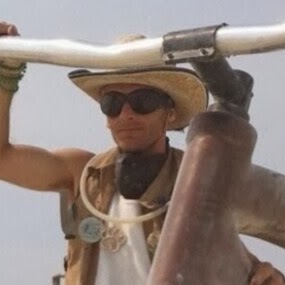Aaron J Parness
age ~43
from Mercer Island, WA
- Also known as:
-
- Aaron Parneff
Aaron Parness Phones & Addresses
- Mercer Island, WA
- Dekalb, IL
- Los Angeles, CA
- Glendale, CA
- Mountain View, CA
- Cambridge, MA
- Stanford, CA
Ranks
-
Licence:Dist. of Columbia - Active
-
Date:2007
Amazon

Curb Mounting, Vertical Mobility, and Inverted Mobility on Rough Surfaces Using Microspine-Enabled Robots
view sourceAuthor
Aaron Parness
Binding
Paperback
Publisher
NASA
ISBN #
2

Terrain Traversing Device Having a Wheel with Microhooks
view sourceAuthor
Aaron Parness
Binding
Paperback
Publisher
NASA
ISBN #
1
Us Patents
-
Terrain Traversing Device Having A Wheel With Microhooks
view source -
US Patent:20130062134, Mar 14, 2013
-
Filed:Sep 7, 2012
-
Appl. No.:13/606885
-
Inventors:Aaron PARNESS - LOS ANGELES CA, US
Clifford F. MCKENZIE - EAGLE SPRINGS NC, US -
International Classification:B60B 9/02
B62D 61/10
B62D 61/00
B60B 37/00 -
US Classification:180218, 280 801, 280 528, 152 1
-
Abstract:A terrain traversing device includes an annular rotor element with a plurality of co-planar microspine hooks arranged on the periphery of the annular rotor element. Each microspine hook has an independently flexible suspension configuration that permits the microspine hook to initially engage an irregularity in a terrain surface at a preset initial engagement angle and subsequently engage the irregularity with a continuously varying engagement angle when the annular rotor element is rotated for urging the terrain traversing device to traverse a terrain surface.
Lawyers & Attorneys

Aaron Parness Esq. - Lawyer
view sourceLicenses:
Dist. of Columbia - Active 2007
Maryland - Active 2005
Maryland - Active 2005
Resumes

Principal Research Scientist
view sourceLocation:
4009 west 7Th St, Los Angeles, CA 90014
Industry:
Defense & Space
Work:
Nasa Jet Propulsion Laboratory Feb 2010 - Sep 2019
Robotics Engineer
Amazon Robotics & Ai Feb 2010 - Sep 2019
Principal Research Scientist
Nasa Jet Propulsion Laboratory Apr 2018 - Sep 2019
Manager, Robotic Climbers and Grippers Group
Nasa Jet Propulsion Laboratory Oct 2013 - Apr 2018
Group Leader, Extreme Environment Robots
Stanford University 2004 - 2009
Phd Student
Robotics Engineer
Amazon Robotics & Ai Feb 2010 - Sep 2019
Principal Research Scientist
Nasa Jet Propulsion Laboratory Apr 2018 - Sep 2019
Manager, Robotic Climbers and Grippers Group
Nasa Jet Propulsion Laboratory Oct 2013 - Apr 2018
Group Leader, Extreme Environment Robots
Stanford University 2004 - 2009
Phd Student
Education:
Stanford University Jan 1, 2004 - 2009
Doctorates, Doctor of Philosophy, Philosophy, Mechanical Engineering Massachusetts Institute of Technology Jan 1, 2000 - 2004
Bachelors, Bachelor of Science, Creative Writing, Mechanical Engineering
Doctorates, Doctor of Philosophy, Philosophy, Mechanical Engineering Massachusetts Institute of Technology Jan 1, 2000 - 2004
Bachelors, Bachelor of Science, Creative Writing, Mechanical Engineering
Skills:
Robotics
Rapid Prototyping
Program Management
R&D
Mechanical Engineering
Leadership
Embedded Systems
Research
Testing
Aerospace
C++
Matlab
Product Development
Proposal Writing
Research and Development
Simulations
Solidworks
Rapid Prototyping
Program Management
R&D
Mechanical Engineering
Leadership
Embedded Systems
Research
Testing
Aerospace
C++
Matlab
Product Development
Proposal Writing
Research and Development
Simulations
Solidworks
Languages:
English
Spanish
Mandarin
Spanish
Mandarin

Aaron Parness
view sourceClassmates

Aaron Parness
view sourceSchools:
Kenwood Elementary School Bend OR 1980-1986, Cascade Junior High School Bend OR 1986-1987, Obsidian Junior High School Redmond OR 1988-1989
Community:
Julie Gregor, Tia Mansfield, Olivia Elliott

Northeastern University -...
view sourceGraduates:
Matthew Lamourie (1992-1995),
Liza Fontinha (1997-2000),
Raye Poole (1994-1996),
Aaron Parness (2002-2005),
Zelia Vieira (2000-2004)
Liza Fontinha (1997-2000),
Raye Poole (1994-1996),
Aaron Parness (2002-2005),
Zelia Vieira (2000-2004)

St. John's College, Annap...
view sourceGraduates:
Corinne Smyth (1995-1999),
Aaron Parness (1996-2000),
Jehanne Dubrow (1993-1997),
Lauren Shofer (1998-2002),
Lura Groen (1994-1998)
Aaron Parness (1996-2000),
Jehanne Dubrow (1993-1997),
Lauren Shofer (1998-2002),
Lura Groen (1994-1998)

Obsidian Junior High Scho...
view sourceGraduates:
Aaron Parness (1988-1989),
Luke Wilkenfeldt (1993-1994),
Jonathan Cook (1981-1981),
Charles Sheldon (1988-1990),
Trishia Reynolds (1984-1986)
Luke Wilkenfeldt (1993-1994),
Jonathan Cook (1981-1981),
Charles Sheldon (1988-1990),
Trishia Reynolds (1984-1986)
Youtube
News

Engineers Design a Robotic Gripper for Cleaning Up Space Debris
view source- "There are many missions that would benefit from this, like rendezvous and docking and orbital debris mitigation," said Aaron Parness, MS '06, PhD '10, group leader of the Extreme Environment Robotics Group at JPL. "We could also eventually develop a climbing robot assistant that could crawl around
- Date: Jun 28, 2017
- Category: Sci/Tech
- Source: Google

Next up on space station: 'gecko' feet, 3-D printer, and playing with matches
view source- NASA jet propulsion engineer Aaron Parness, one of the leaders behind the project, has high hopes for the gecko grippers. The technology could even be used to grab satellites someday, Mr. Parness says. If they work on the International Space Station, gecko grippers could also become part of daily
- Date: Mar 23, 2016
- Category: Sci/Tech
- Source: Google

Astronauts will soon be able to 3D PRINT in space
view source- The Gecko Gripper technology may lead to terrestrialversions of grippers that could, for example, hold flat-screenTVs to walls without anchoring systems and adhesives, said leadresearcher Aaron Parness with Nasa's Jet Propulsion Laboratoryin Pasadena, California.
- Date: Mar 23, 2016
- Source: Google

Cargo ship carrying cool science experiments into orbit
view source- "Geckos have lots of tiny hairs on their feet that help them to stick to things using Van der Waals force," said Aaron Parness, the principal investigator, referring to molecular forces that cause atoms and molecules to be attracted to those making up a surface.
- Date: Mar 22, 2016
- Category: Sci/Tech
- Source: Google
Googleplus

Aaron Parness

Aaron Parness
Plaxo

Aaron Parness
view sourceGet Report for Aaron J Parness from Mercer Island, WA, age ~43





